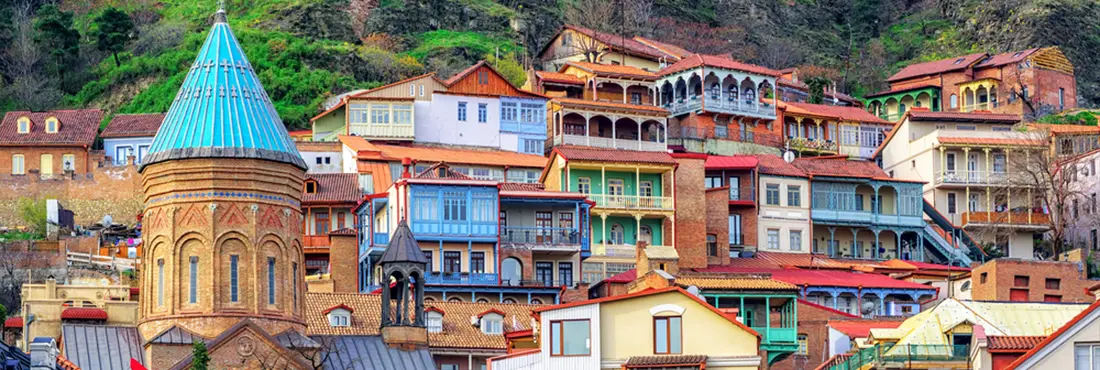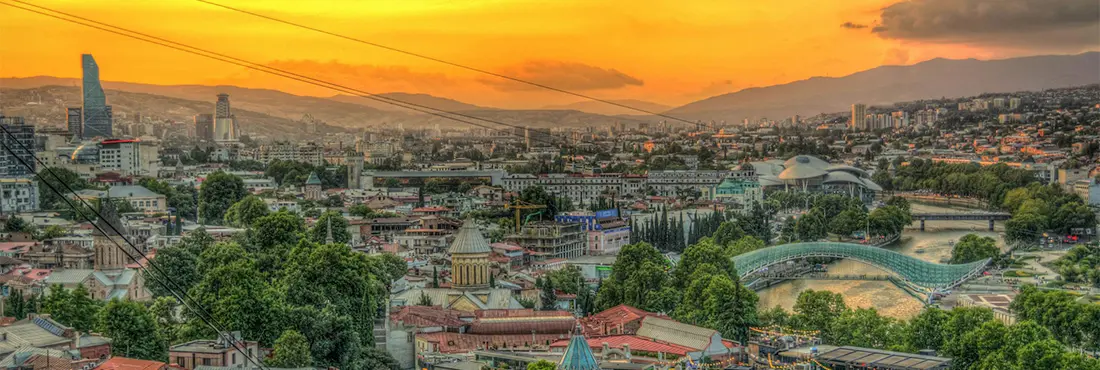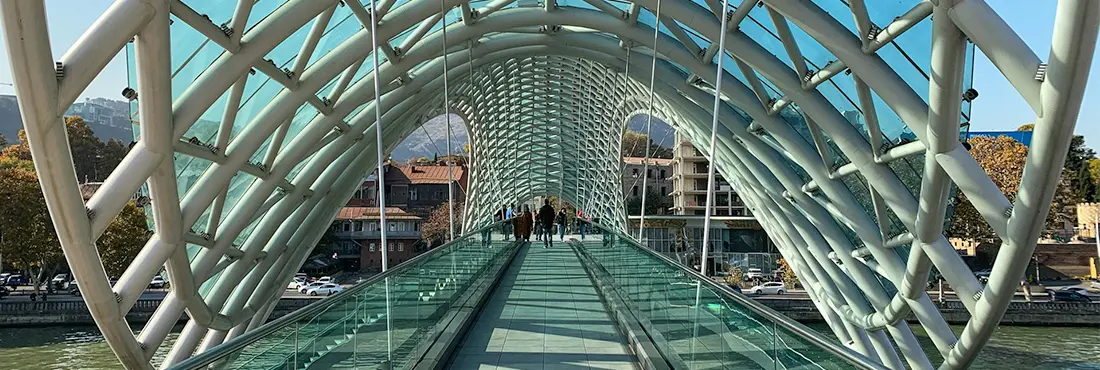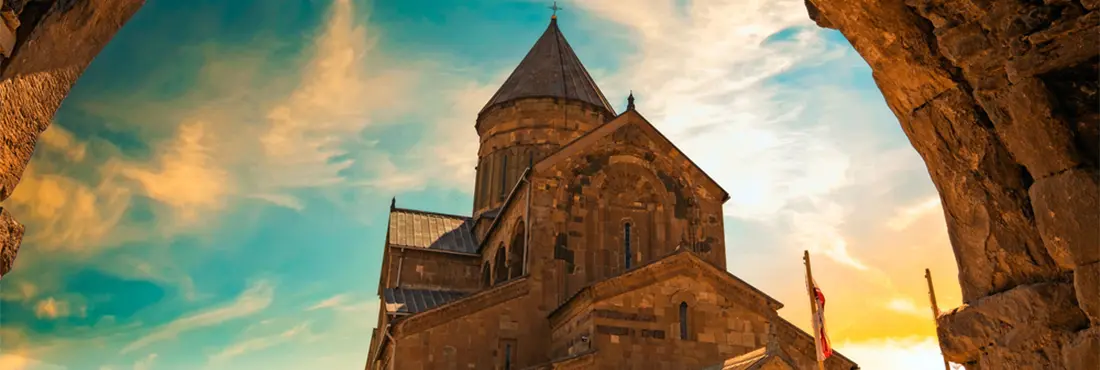Georgia truly has an atmosphere like no other: with its east-meets-west vibe, delicious cuisine, breathtaking scenery, and extremely friendly locals, it’s a great place to visit on holiday, whether you’re travelling with family, friends, or as a couple - and the great news is, UAE residents can visit on holiday without a visa. Whether you are a UAE national or an expat with a valid residency permit, you can enjoy a short-term tourist visa on arrival for up to 90 days in any 180-day period. Please note there are documents required to process a visa on arrival. Contact our visa team for more information.
Its capital, Tbilisi, is the largest city in Georgia, home to 1.1 million people; and has a history dating back to 4,000 BC. That being said, the city is fairly compact, meaning you can easily explore all the key sights and attractions in just a few days, enabling you to travel onward to other Georgian cities, or the nearby capitals of Yerevan and Azerbaijan.
So, if you’re
visiting the capital on a Georgia tour, read on to discover all of the places to visit in Tbilisi while you’re there.
Day one
With so many things to see and do in Tbilisi, like any other city, the best way to spend your first day is to get your bearings of the city centre, and see all of the key attractions.

Morning
Get up early and enjoy a hearty breakfast before spending your morning wandering around the Old Town. Be prepared to get lost down winding alleyways lined with charming yet crumbling buildings that’ll showcase Tbilisi’s long and colourful history.
Tbilisi has an east-meets-west feel, and that shines through in its Old Town, as you’ll be treated to a sight of the real Tbilisi. Situated on the southern banks of the Mtkvari River, start your exploration at The Clock Tower, which was built in the 1800s, and wander around its nearby streets, lined with souvenir shops and cafes.
Head to Dry Bridge Market, which is one of the most popular things to do in Tbilisi. Open every single day, this flea market is particularly good if you want to find paintings from local artists, or Soviet memorabilia - just be prepared to haggle!
With Tbilisi’s history firmly rooted in the Ottoman era, you’ll want to spend some time at one of the thermal baths, most of which are located in the Old Town. Some require pre booking a room, whereas you can turn up at other ones, so it’s important you do your research before you decide to go.
If you’ve ever visited the thermal baths in Budapest or Istanbul, be prepared for this to be a different experience. Tbilisi’s baths are sulphur, with temperatures reaching 38-40 degrees Celsius (so you won’t want to spend too long in there!). You’ll have the option to book a private room or stay in a common area, and in some of the more upscale houses, you can book treatments such as massages and kisi (exfoliating) scrubs.

Afternoon
Feeling fully relaxed from your sulphur bath experience, take the cable car up to Narikala Fortress, which is a key Tbilisi tourist attraction. Wander past the ruins, which date all the way back to the fourth century, and admire the beautiful views of the Old Town.
Once you’ve finished there, head to the Botanical Gardens, which are just 100 metres away. The entry fee is extremely cheap, at around 4 GEL (5.35 AED), and you can easily spend a good couple of hours discovering all of the different types of trees and flowers, alongside the several greenhouses - one of which is a French orangerie.
From there, a five-minute walk will take you to the imposing Mother Georgia statue, which is without a doubt, one of the best places to visit in Tbilisi - especially on your first day. Also known as Kartlis Deda, she stands at the top of the hill, watching proudly over the city. It also happens to be one of the best places to watch the sunset over Tbilisi, with the fusion of architectural styles evident here - from futuristic bridges, through to communist-style blocks, and majestic bath houses.
In the warmer months, street performers will gather here to play musical instruments, so make sure you turn up early to find a bench and watch the world go by.
Evening
When it starts to get dark, take the cable car back down to the Old Town, and head to Shardeni Street, which is lined with lots of outdoor bars and restaurants. Here, you can sample traditional Georgian dishes, from khachapuri, which is a canoe-shaped bread filled with melted butter, gooey cheese, and topped off with an egg; khinkali, which are delicious dumplings filled with cheese and different meats; or lobio, which is a kidney bean and walnut stew.
Day two
Now you’ve got your bearings, it’s time to discover some more tourist places in Tbilisi, and get to the heart of Georgia’s capital.
Morning
Georgia is recognised as the second country in the world after Armenia to adopt Christianity; and with the country extremely welcoming of all faiths, you can see the importance of religion everywhere you look. That’s why you should start your day early, and tour some of the best churches that Tbilisi has to offer - each providing something special and unique.
Head to Holy Trinity Cathedral of Tbilisi (also referred to as ‘Sameba’) for your first stop. Not only is it the largest church in all of Georgia, but it’s one of the biggest Eastern Orthodox cathedrals in the world. Nestled on the top of Elia Hill, it’s a 30-minute walk from the Bridge of Peace; but as you climb up the stairs, only then will you appreciate the sheer scale of the cathedral.
Situated in the same location where an old Armenian church once stood, which was destroyed during the USSR, head round the back and you’ll be able to see some of the old gravestones, with the cemetery the only thing that survived.
From there, head back to the banks of the Mtkvari River to visit Metekhi Virgin Mary Assumption Church, which appears to be dramatically hanging off a cliff (don’t worry, it’s not!). It’s an understatement to say this church has seen a lot of history - it was used as a prison during the USSR, but it’s now back to being a place of worship.
Other churches that you should visit while in Tbilisi include Kashueti St. George Church, which is located on Rustaveli Avenue - one of the busiest streets in Tbilisi - and has lots of brightly painted murals inside; and the Blue Monastery, which has been given its name because of its blueish-grey facade.

Afternoon
Visit Tbilisi’s Old Town and you’d be forgiven for thinking the entire city is full of winding alleyways. However, you’ll soon come to see that Tbilisi is a city of contrasts, and the same goes for its architecture.
Spend your second afternoon exploring the more modern side of the Georgian capital. Cross the pedestrian Bridge of Peace to get to the north of the city, and it’ll give you a futuristic feel, with its glass and steel design, and wander along the river’s banks.
Freedom Square is a 12-minute walk from the bridge, and is a key meeting point for locals. Like most of the city, it’s seen its fair share of history, which is why it’s one of the top tourist places in Tbilisi. Initially named ‘Freedom Square’ in 1918, when Georgia became independent from Russia, it was renamed during the USSR, before switching back in 1991.
Pushkin Park is a small stretch of green space right by Freedom Square that’s worth a quick visit. It’s home to a small fountain and a couple of statues, and is also the meeting point of Tbilisi Free Walking Tours, which offer tours around the city every day.
If you want to indulge in some retail therapy, then you can’t go wrong with Rustaveli Avenue, which starts at Freedom Square, and stretches 1.5km, and is home to lots of international fashion brands.
Evening
Enjoy an evening of culture at the Opera and Ballet Theatre of Tbilisi, which is handily located on Rustaveli Avenue.
The theatre has an extensive programme showcasing all of the classics, from Sleeping Beauty and Swan Lake, through to Carmen and The Nutcracker, so no matter what time of the year you visit Tbilisi, you should be able to watch a show - just make sure you book ahead to avoid disappointment.
When it comes to getting dinner, there are lots of restaurants situated just off Rustaveli Avenue where you can grab something, with traditional Georgian cuisine, as well as international options available.
Day three
Rounding off your third full day in Tbilisi, there are lots of nearby sights that you can easily see on a half-day trip, to get a feel of the rest of Georgia.

Morning
Whether you pre book a tour, or turn up to one of the travel agencies by Freedom Square, there are lots of places you can easily visit from Tbilisi, with Mtskheta and Uplistsikhe two of our favourites.
The former capital of Georgia, Mtskheta is a 30-minute drive north of Tbilisi, and is often referred to as the ‘second Jerusalem’. Start at Jvari Monastery, which is located just outside of the city, for unrivalled views of the Caucasus, as well as the meeting point of the Mtkvari and Aragvi rivers.
From there, head to the centre of Mtskheta and visit Svetitskhoveli, which is the second largest cathedral in Georgia after Sameba, alongside Samtavros Convent, which is an active nunnery that’s a UNESCO-protected monument, and the Tree of Life Mosaic, which shows images of traditional Georgian life and culture.
Alternatively, if you’re happy to travel slightly further afield, you could spend half the day in Uplistsikhe. An hour and a half drive from Tbilisi, it’s one of the oldest and most striking cave towns in Georgia. Once inhabited by merchants and traders, climb over the staircases and alleys to discover what used to be homes and communal areas, and enjoy uninterrupted views of the Georgian countryside.
Afternoon
Once you’ve gotten back to the capital, spend the rest of the day unleashing your inner child at Mtatsminda Park. One of the best things to do in Tbilisi, this theme park is nestled at the top of Mount Mtatsminda, and is reachable by funicular, with the station just a short walk from Rustaveli Avenue.
Go wild on the 60 different rides, which range from gentle children’s rides, through to the towering ferris wheel that looms over the city, and a couple of faster roller coasters. Mtatsminda Park also has a few different restaurants and cafes, as well as playgrounds and a bowling alley, so make sure you set aside at least a few hours here.
Evening
With this being your last night in Tbilisi, you’ll want to make it count. Sample other Georgian delicacies that you haven’t yet tried, such as ajapsandali, which is a spicy aubergine dish served with a medley of vegetables, and mtsvadi, which is typically skewered beef or lamb, paired with a sour plum sauce.
Finish the night with churchkhela, which you can find at many traditional restaurants and street food vendors. It may be an acquired taste, but it’s a staple of any Georgian diet: walnuts coated in concentrated grape juice, they look like long wavy strands, but are actually a classic dessert!
With so many things to do in Tbilisi, it can be hard knowing where to start, but even if you have just a few short days in the Georgian capital, you can see all of the key tourist places, and get a feel for what the rest of the country has to offer.
Flight times from Dubai tend to be three and a half hours, making it a great option for a city break; and if it’s somewhere you’re considering going, we can help you to find the perfect hotel.
Alternatively, for more travel inspiration, head on over to our blog where you can find out everything from the top things to do in Abu Dhabi with kids, through to the benefits of going on a cruise, and everything in between.

